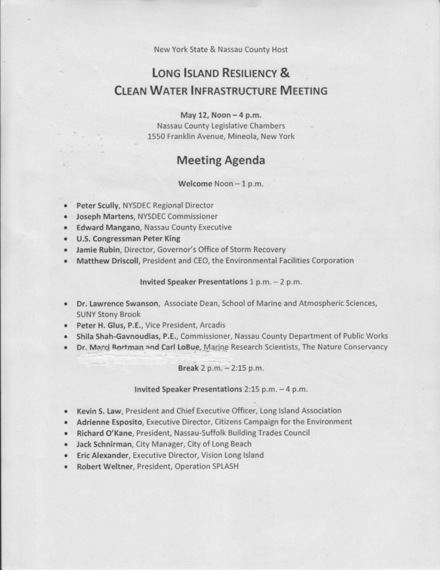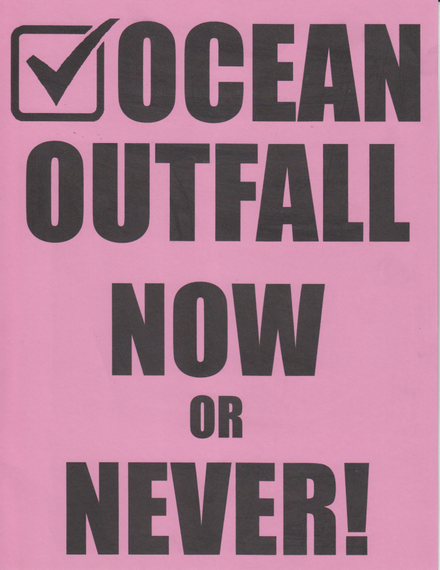The first of four public meetings scheduled this month on Long Island's water quality crisis was held Monday, May 12, 12-4 p.m. in the Nassau County Legislative Chambers which are appropriately enough in the Theodore Roosevelt Executive Office Building at 1550 Franklin Avenue, Mineola. The next meeting will be at Stony Brook University May 19, time and place TBD. (Email me at marshall@savethegreatsouthbay.org for that.) Here is the press release announcing Governor Cuomo's initiative to improve water quality and resiliency on Long Island.
This first meeting featured 18 speakers -- state environmental officials, scientists, environmental nonprofit organizations, and local business and community leaders. The topic was how to best rebuild the Bay Park Sewage Treatment Plant, severely damaged by Sandy, and with that begin to restore the Western Bays along the south shore of Nassau County.
There were otherwise about 50 people from the general public, many from Operation Splash!, a Freeport-based local environmental group that has over the past 20+ years removed over a million pounds of trash from The Western Bays.
Both the speakers and the attendees were united in this -- as we rebuild from Sandy, we have a once-in-a-generation opportunity to rebuild. As Joseph Martens, Commissioner New York State Department of Environmental Conservation, put it: "better, smarter, stronger," while adopting "the best science available."
What the most recent science on the Western Bays, as per a NYSDEC report you can read here, with the press release for that report being here is that even before Sandy, The Bay Park STP was contributing mightily to the degradation of marshlands and water quality because the treated effluent was being emptied out right into the Western Bays and Reynolds Channel. The whole area flushes poorly, with each 65,000,000 gallons pouring in, an amount equal in volume, according to Rob Weltner, Executive Director of Operation Splash!, of what the Exxon Valdez was carrying.
The plant serves 500,000 Nassau residents, but is also the source of 80 percent of the nitrogenous waste in the Western Bays. That nitrogen has over the decades, been systematically weakening the root structures of a vast expanse of marsh lands and causing them to erode away. These marsh lands are of course habitats for fish, birds, and shellfish, but crucially, they also provide a buffer against storms; without the marshes, southern Nassau is highly vulnerable to flooding and storm damage.
With the $810 million to rebuild the Bay Park Sewage Treatment plant, Nassau County has the opportunity to accomplish two goals at once -- habitat restoration, and shoreline protection. Build a state-of-the-art plant to replace a 50-year-old, antiquated plant, and we can have our nature -- and the protection it provides -- back.
Carl LoBue, Senior Marine Scientist at The Nature Conservancy, pointed out a third and fourth benefit. This rebuilding can help preserve a way of life. Ninety-seven thousand boater licenses have been issued for Nassau County, not including kayaks and paddle boards. Swimming, fishing, clamming, beach-going, is part of the fabric of Long Island. What we are seeing instead in the Western Bays, with all the excess nitrogen from The Bay Park Sewage Treatment Plant, are noxious blooms of a type of algae called ulva, or sea lettuce. In summer it piles up constantly on the beaches, rotting and releasing hydrogen sulfide gas. With that, we are losing the very reason people would want to live on Long Island and along the south shore of Nassau County. Which brings us to the fourth reason -- real estate value preservation. Restore the marshes and Western Bays, and watch home values rise, as the waters return to their former beauty.
The rebuilding of the Bay Park Plant, all argued, would be utterly incomplete without an accompanying "ocean outfall pipe." Without such a pipe, a new plant would only continue to dump excess nitrogen into the Western Bays, and their dying off would continue. An outfall pipe would extend out three miles into the ocean, with the effluent further treated. The pipe would cost hundreds of millions of dollars more, and would have to be approved by HUD and FEMA, but if the outfall pipe were to be built in conjunction with the Bay Park Plant also treating waste water from a newly sewered Long Beach, and with the waste water treatment of a third community, the total price for that larger scale sewage infrastructure would actually cost less overall.
All said, this plan, developed by our leading environmental scientists in the state government, from academia and from our local environmental nonprofits would vastly improve water quality and with that coastal resilience against future storms.
Adrienne Esposito, Executive Director of The Citizen's Campaign For The Environment stated, "this is truly a turning point for Long Island." For 10 years she and Mr. Weltner and those in their organizations had advocated for a new plant and an outfall pipe to save the Western Bays. Now because of Sandy, Long Island has both the resources and the will to accomplish this, especially if FEMA and HUD consent to adopt the plan that would include the outfall pipe, something all the assembled public officials and Governor Cuomo, who called for this initiative, agreed was necessary to rebuild "better, smarter and stronger." As she advocated passionately for the outfall pipe, dozens held up this sign:
Adrienne also offered this important coda: While most of Nassau County is on sewers, much of Long Island's "Gold Coast," -- Manhasset, Glen Cove, Oyster Bay, Bayville -- some 30 north shore communities in all, are on septic tanks.
We need only see the results of that in the Long Island Sound and the loss of around 80 percent of our salt marshes there since 1974, according to Professor Christopher Gobler of Stony Brook University. But that part of Long Island will be addressed in the next installment of "Can Long Island Be Saved?"


